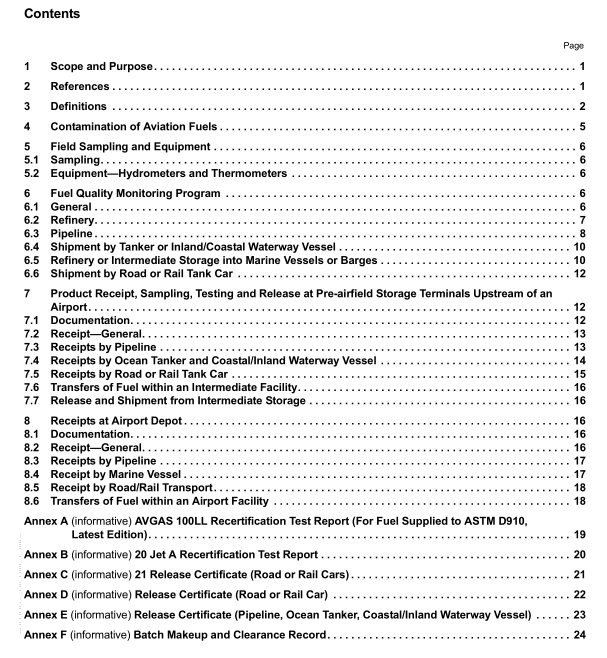API RP 1543 pdf download

API RP 1543 pdf download Documentation, Monitoring and Laboratory Testing of Aviation Fuel During Shipment from Refinery to Airport
lt shall include details relating to the identity of the originating RQC andJor COAs to allow the traceability of theproduct described. lf the originating RQCs are not available, then a COA shall be completed with a note stating:
“Certfied that this sample meets the relevant specification with respect to the above tests and complies withASTM DXXXX Latest Revision. No certification is given regarding the types and amounts of any additives that may bepresent other than those reported above.”
3.15.2
delivery documentDD
This document supports any delivery of product. It is used to document the volume of product moved, pricing andother information required such as product hazard classification and other regulatory requirements. The mostcommon DD is the bill of lading (BOL) document used in road or rail transport deliveries.
3.15.3
recertification test certificateRTC
Where aviation product is transferred to an installation under circumstances which could in any way allow thepossibility of contamination, then before further use or transfer,recertification is necessary.Recertication testing iscarried out to verify that the quality of the aviation fuel concerned has not changed and remains within thespecification limits, for example, after transportation in ocean tankers or multiproduct pipelines, etc. The RTC (seeAnnex A and Annex B for minimum requirements) shall be dated and signed by an authorized representative of thelaboratory carrying out the testing. The results of all recertification tests shall be checked to confirm that:
-the specification limits are met, and
-no significant changes have occurred in any of the properties.
The results of such tests shall be compared to the expected calculated results from a weighted average of theprevious tank recertification and the receiving batches RQC or COA as well as reviewed for compliance with thespecification limits. If any test results indicate that the sample does not comply with applicable specifications or isoutside the allowable variance, the product shall be immediately quarantined and remain under quarantine untilfurther testing has established that the quality is acceptable for aviation use. If more than three new batches arereceived into a tank, the comparison becomes difficult and possibly meaningless, and therefore the contents of thetank shall be tested against all the requirements of the specification.
lf the incoming product is not accompanied by an RQC or COA or one is not available,then full COA laboratorytesting is required to verify that the fuel is still within the limits of the fuel specification. Iin this case the amount andusage of approved additives in the fuel is unknown.
3.15.4
refinery certificate of qualityRQc
This certficate is the definitive original document describing the quality of an aviation fuel. As well as containingdeterminations of all the properties required in the relevant specification(s), it provides information regarding the typeand amount of any additives in the fuel. it therefore represents a complete certification of a products conformancewith the relevant specification.RQCs shall always be dated and signed by an authorized representative of therefinery’s quality organization and document the fuel specification manufactured against it (ie.ASTM D1655 latestrevision for Jet A or Jet A1,ASTM D910 latest revision for aviation gasoline).
3.15.5
release certificateRC
This document supports any transfer of product,confiming compliance with the relevant specification(s), andcontains at least the following information (see Annex C and Annex D for use by road or rail transport, and Annex Efor pipeline or marine vessely below.
a) Date and time of transfer.
b)Grade of fuel.
c)Batch number and batch APl Gravity at 60 °F(density at 15 “C) of the product in the tank(s) from which it
originated. If more than one batch is being included in any shipment then the quantity from each batch is requiredto be stated on the release document.
NOTE15 *℃is the intermnationally accepled temperature for conversion to standard temperature conditions, but some areas arerequired to use 20C(6B”F).
d)Confrmation that the storage tanks and filtration (where applicable) have been sumped and are free of visible
water.
e) Signature of person authorized to release the product.3.16
upper sample
A sample obtained from the middle depth of the upper third of the tank contents.
4Contamination of Aviation Fuels
Aviation fuel can become contaminated during transport resulting in product that is unsuitable for use.Contaminationcan arise from other products and from additives [e.g. static dissipater,corrosion inhibitor, drag reducing additives(DRAs)】 used in other products,which can affect fuel properties even in extremely small concentrations,Wherevercontamination of this nature can occur (nondedicated transport or nonsegregated storage), recertification testing shallbe performed to confirm that the fuel was delivered on specification with no significant changes to any of the properties.lt is important that the results of the quality checks (see Annex A and Annex B for minimum requirements) are comparedwith the results from the refinery certficate of quality (RQC) or most recent certificate of analysis (COA) to determine ifcontamination has occurred. lt is not sufficient to compare results against the specification limits alone.









